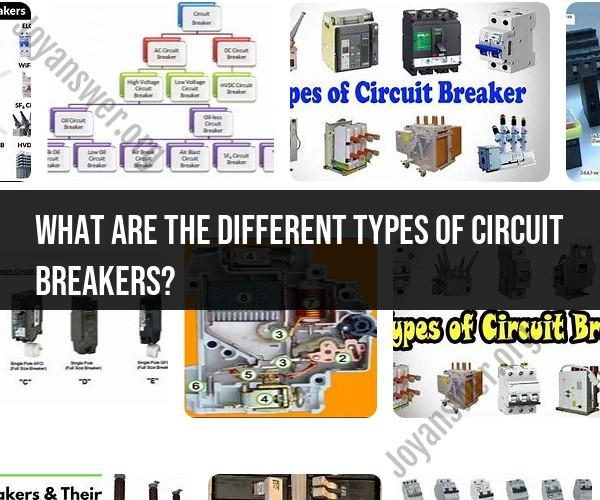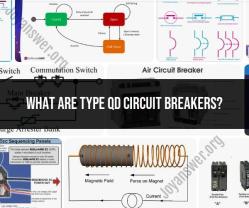What are the different types of circuit breakers?
Circuit breakers are essential electrical devices used to protect electrical circuits and equipment from overloads, short circuits, and other electrical faults. There are several types of circuit breakers, each designed for specific applications and operating principles. The most common types of circuit breakers include:
Miniature Circuit Breakers (MCBs):
- MCBs are commonly used in residential and commercial electrical installations.
- They provide protection against overcurrents and short circuits.
- MCBs are available in various current ratings and trip curves to suit different applications.
Molded Case Circuit Breakers (MCCBs):
- MCCBs are used in industrial and commercial settings to protect larger electrical systems.
- They offer adjustable trip settings and are capable of handling higher current ratings.
- MCCBs are often used in distribution panels and electrical control panels.
Residual Current Circuit Breakers (RCCBs):
- RCCBs, also known as ground fault circuit interrupters (GFCIs) in the United States, are designed to protect against ground faults and electric shock.
- They monitor the balance of current between the live and neutral conductors and trip when an imbalance is detected.
- RCCBs are commonly used in bathrooms, kitchens, and outdoor electrical circuits.
Arc Fault Circuit Interrupters (AFCIs):
- AFCIs are designed to detect and prevent electrical fires caused by arcing faults.
- They are typically used in residential electrical systems to protect against arc faults in wiring and devices.
Air Circuit Breakers (ACBs):
- ACBs are used in high-voltage applications, such as large industrial and commercial installations.
- They can handle high fault currents and provide adjustable trip settings.
- ACBs are often used to protect power distribution systems.
Oil Circuit Breakers (OCBs):
- OCBs are high-voltage circuit breakers filled with oil to provide insulation and arc extinction.
- They are commonly used in high-voltage power transmission and distribution systems.
Vacuum Circuit Breakers (VCBs):
- VCBs are high-voltage circuit breakers that use a vacuum to quench the arc during circuit interruption.
- They are often used in medium to high-voltage applications and are more environmentally friendly than OCBs.
Gas Insulated Circuit Breakers (GICBs):
- GICBs use sulfur hexafluoride (SF6) gas to provide insulation and arc extinguishing properties.
- They are used in high-voltage substations and switchgear applications.
Circuit Breaker Panels (Distribution Boards):
- These panels contain multiple circuit breakers to distribute power within a building.
- They typically house MCBs, RCCBs, and other types of circuit protection devices.
Specialized Circuit Breakers:
- Various specialized circuit breakers exist for specific applications, such as motor protection circuit breakers, generator circuit breakers, and circuit breakers designed for explosive environments.
The choice of circuit breaker type depends on the specific electrical system, its voltage rating, current capacity, and the level of protection required. Safety regulations and local electrical codes also play a significant role in determining which type of circuit breaker to use in a given application.
Different Types of Circuit Breakers and Their Roles
Circuit breakers are essential safety devices that protect electrical circuits from overloads and short circuits. They automatically interrupt the flow of electricity when a fault is detected, preventing damage to wiring, appliances, and even preventing fires. There are several types of circuit breakers, each designed for specific applications and current ratings.
Circuit Breaker Categories: Thermal, Magnetic, and Hybrid
Circuit breakers are categorized based on their tripping mechanism, which determines how they detect and respond to faults.
Thermal Circuit Breakers: These breakers utilize a bimetallic strip that bends when heated by excessive current. This bending action triggers the breaker to trip, protecting the circuit from overloads.
Magnetic Circuit Breakers: These breakers employ an electromagnet that reacts to sudden surges in current, such as those caused by short circuits. The electromagnet quickly pulls the breaker contacts apart, interrupting the flow of electricity.
Hybrid Circuit Breakers: These breakers combine both thermal and magnetic tripping mechanisms, offering protection against both overloads and short circuits. They are commonly used in residential and commercial applications.
Specialty Circuit Breakers for Specific Applications
In addition to the standard thermal, magnetic, and hybrid circuit breakers, there are specialty breakers designed for specific applications:
Ground Fault Circuit Interrupters (GFCIs): These breakers protect against electrical shocks by detecting ground faults, where current flows through an unintended path, such as through a person's body.
Arc Fault Circuit Interrupters (AFCIs): These breakers protect against arc faults, which are dangerous electrical arcs that can cause fires. AFCIs are often used in bedrooms and living areas where arc faults are more likely to occur.
Circuit Breaker Selection for Residential and Industrial Use
The selection of the appropriate circuit breaker depends on the application and the current requirements of the circuit.
Residential Circuit Breakers: For residential applications, circuit breakers with lower current ratings, typically ranging from 15 to 200 amps, are used. These breakers are designed to protect household circuits and appliances.
Industrial Circuit Breakers: Industrial applications often require circuit breakers with higher current ratings, ranging from hundreds to thousands of amps. These breakers are designed to handle the higher power demands of industrial equipment and machinery.
Safety, Maintenance, and Replacement of Circuit Breakers
Circuit breakers play a crucial role in electrical safety and should be properly maintained to ensure their effectiveness.
Regular Inspection: Circuit breakers should be inspected regularly for signs of damage, overheating, or loose connections.
Testing: Periodic testing of circuit breakers is recommended to ensure they trip properly under fault conditions.
Replacement: If a circuit breaker shows signs of wear or malfunction, it should be replaced by a qualified electrician.
Remember, circuit breakers are essential safety devices that protect your electrical system and prevent electrical hazards. Proper selection, installation, and maintenance of circuit breakers are crucial for ensuring the safety of your home or workplace.







